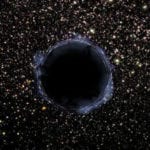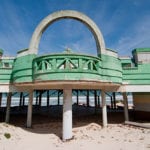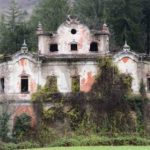 Humans
Humans  Humans
Humans  Travel
Travel 10 Best Hiking Trails in America with Breathtaking Views
 Weird Stuff
Weird Stuff The 10 Weirdest Materials That Can Be Used to Make Paper
 Crime
Crime The 10 Most Infamous Gangs in History
 Miscellaneous
Miscellaneous Ten Groundbreaking Tattoos with Fascinating Backstories
 Our World
Our World 10 Green Practices That Actually Make a Difference
 Humans
Humans Ten Historic Men Who Deserve Way More Credit Than They Got
 Movies and TV
Movies and TV The 10 Most Heartwarming Moments in Pixar Films
 Travel
Travel Top 10 Religious Architectural Marvels
 Creepy
Creepy 10 Haunted Places in Alabama
 Humans
Humans Ten Journalists Who Got Caught Faking the News
 Travel
Travel 10 Best Hiking Trails in America with Breathtaking Views
 Weird Stuff
Weird Stuff The 10 Weirdest Materials That Can Be Used to Make Paper
Who's Behind Listverse?

Jamie Frater
Head Editor
Jamie founded Listverse due to an insatiable desire to share fascinating, obscure, and bizarre facts. He has been a guest speaker on numerous national radio and television stations and is a five time published author.
More About Us Crime
Crime The 10 Most Infamous Gangs in History
 Miscellaneous
Miscellaneous Ten Groundbreaking Tattoos with Fascinating Backstories
 Our World
Our World 10 Green Practices That Actually Make a Difference
 Humans
Humans Ten Historic Men Who Deserve Way More Credit Than They Got
 Movies and TV
Movies and TV The 10 Most Heartwarming Moments in Pixar Films
 Travel
Travel Top 10 Religious Architectural Marvels
 Creepy
Creepy 10 Haunted Places in Alabama
Top 10 Structures That Seem to Defy Gravity
Architecture is an incredible craft. Beautiful buildings and other structures are being designed and built to fit specific needs. Beauty and aesthetics can be key elements for architects. However, the most important requirement for any building is to remain upright!
Architects continue to push the boundaries of gravity, designing buildings that appear to define all written rules, often mysteriously and beautifully. All around the world, unique structures are created that seem to defy both gravity and logic.
We will look at the top ten structures that seem to defy gravity in the list below.
Related: 10 Most Haunted Buildings In New York City And Their Backstories
10 Takasugi-an (Tea House on the Tree)
In Chino, Japan, architect Terunobu Fujimori designed Takasugi-an. Translated from Japanese, Takasugi-an means “a tea house built too high.”
Takasugi-an was designed with meditation and tea in mind. It is a simple design of a small tea house with one significant difference; this tea house sits upon two chestnut tree trunks. It almost looks like the tiny house is on stilts.
The Tea House on the Tree is high above the nearby trees and allows for a different perspective on nature. While Takasugi-an is only a single room, it leaves a much bigger impression. Despite the translation, it seems this tea house was built at just the right height to make a big impact.
9 Endless Bridge
In Minneapolis, Minnesota, in the United States, another structure seems to defy both logic and gravity. The Endless Bridge was designed by architect Jean Nouvel and opened to the public in 2006. Despite the name, this structure is (obviously) not endless, but it is also not even a bridge! It does not cross the Mississippi River or even close to it. However, the purpose of the Endless Bridge was to create a unique viewing experience for America’s largest river.
As the signature part of the Guthrie Theater, the Endless Bridge extends nearly 200 feet north of the building, offering a wide view of the Upper Saint Anthony Falls area as well as the Stone Arch Bridge (another architectural feat). Patrons are not expected to pay any admission fee to see these great views from this incredible work of architecture. From outside of the Guthrie Theater, the Endless Bridge really appears to defy gravity.
8 Odeillo Solar Furnace
In Font-Romeu-Odeillo-Via, France, lies the largest solar furnace in the world. The Odeillo Solar Furnace is 54 meters (177 feet) tall and 48 meters (157 feet) wide. While that is impressive enough in its own right, the efficient design of the building makes it appear to defy gravity as well.
Font-Romeu-Odeillo-Via was chosen for the Odeillo Solar Furnace because it receives a great deal of quality sunlight throughout the year. The furnace itself features an extremely large concave mirror (over 6,400 square meters or 21,000 square feet) across the front of the building.
This series of mirrors redirect the sunlight to a small point within the mirror. This allows valuable sunlight to be harvested for many purposes. It also makes for a very odd sight, defying gravity, providing energy and beauty all at once. This amazing structure was built by engineer Felix Trombe throughout the 1960s and opened in 1970.
7 Museum of Tomorrow (Meseu do Amanhã)
The Museum of Tomorrow seems to float above the ocean. The Museum of Tomorrow in Rio de Janeiro, Brazil, was completed and opened to the public in 2015. Amazingly, the museum hosted nearly 1.5 million guests in its first year alone. It is still the most visited museum in Brazil today.
Santiago Calatrava designed the Museum of Tomorrow to explore the relationship between nature and the city. As the name implies, Calatrava created the design with the future in mind. Therefore, there are many forward-thinking designs, including recycled water, solar panels, rainwater collection, and more.
Native species are also used around the Museum of Tomorrow. In fact, despite its impressive appearance, the Museum of Tomorrow was limited to only about 4.5 meters (15 feet) of height so that it did not block the nearby Sao Bento Monastery (which is a UNESCO world heritage site). A beautiful structure that appears to defy gravity, the Museum of Tomorrow will be one of Brazil’s most important museums not only tomorrow but many years into the future as well.
6 Dancing House
A unique structure in Prague, Czech Republic, is called Dancing House. Two architects worked together to design this structure that was completed in 1996. Vlado Milunić and Frank Gehry teamed up to create this beautiful building that looks like it is defying gravity.
Dancing House is also called Ginger and Fred, after famous dancers Ginger Rogers and Fred Astaire. As the name implies, the structure appears to show two structures, a masculine and a feminine structure, dancing together. Prague hired these architects to create an iconic building, and Gehry and Milunić clearly succeeded.
The Dancing House really appears to defy gravity with its bends and twists, illustrating a kind of movement. However, this incredible structure is used for a somewhat ordinary purpose… office buildings. Too bad it isn’t used as a dance studio!
5 Hypo Alpe-Adria Bank (Headquarters)
While this name may be hard to say, the structure is certainly easy on the eyes. A three-person team designed this breathtaking building. Karin Elzenbaumer, Sebastian Gretzer, and Veronica Reiner collaborated to create the Hypo Alpe-Adria Bank headquarters.
The bank may have been in existence since the late 1800s, but this gravity-defying structure was designed in 2004 and built in 2006. The Hypo Alpe-Adria Bank is located at the northern edge of Udine, Italy (in a small town called Tavagnacco).
The Hypo Alpe-Adria Bank is constructed as interwoven components coming together. It is designed to appear to be leaning. Although the building itself leans 14 degrees to the south, all columns are fully vertical. This creates a wondrous sight and allows the lower portions of the bank headquarters to enjoy the shade while enjoying unobstructed views. There is plenty of reason for hype regarding the Hypo Alpe-Adria Bank headquarters.
4 Balancing Barn
In Suffolk, the United Kingdom, a barn appears to defy gravity. In 2010, Dutch architecture firm MVRDR designed and developed this unique structure.
Unlike many other structures on this list, the Balancing Barn is only a single story. It appears to be halfway on the ground, while the other half appears balanced over the edge of a hill, propped up only by a small beam. The Balancing Barn is a rental house that appears to teeter on the edge of collapse.
In addition to its gravity-defying qualities, the Balancing Barn is constructed of metal and reflects brightly in the English sun. Despite the unique and somewhat awkward appearance, the Balancing Barn is comfortable and well-furnished on the inside.
From one end of the home, visitors enter on the ground level. Without going up any stairs, a visitor can walk to the other end of the Balancing Barn to get a lovely view of nature from a higher perspective. Compared to many structures on the list, the Balancing Barn is relatively simple, creating quite a striking image.
3 Torre Mare Nostrum
Torre Mare Nostrum is an office building in Barcelona, Spain. It was designed by architects Enric Miralles and Benedetta Tagliabue and was completed in 2008.
Unlike typical office buildings, Torre Mare Nostrum appears suspended in mid-air. Torre Mare Nostrum’s dominant feature is a horizontal block of the building that sticks out from the main structure. The main structure features 20 stories and reaches over 280 feet in height. The projection out of the building is five floors high and sticks out about 131 feet from the main structure. Like many similar structures, Torre Mare Nostrum contains four concrete cores despite the intricate design.
A unique take on an office building, this structure stands out in Barcelona as Torre Mare Nostrum was the last building designed by Enric Miralles, and the work did not finish until after his death.
2 Seattle Central Library
After two and a half years of design and construction, the Seattle Central Library opened in 2004. The design of this building is based not only on the architect’s wishes but also on the interior floor plan of the building. Designed by Rem Koolhas and Joshua Prince-Ramus, the Seattle Central Library features an overhang that looks to be only connected to the top edge of the main building.
In addition to the breathtaking, gravity-defying aesthetic, the Seattle Central Library also features unique rooms, including a “mixing chamber” (computers and customer assistance), a children’s center, and a “living room” (teen books, coffee bar, auditorium, and study rooms). Thanks to the excellent design, these areas receive a good deal of natural sunlight throughout the day. The building is also designed to be energy conscious and not waste any space. The Seattle Central Library has been a welcome, gravity-defying addition to the Seattle skyline.
1 De Rotterdam Building
The last building on this list is also one of the most impressive. The De Rotterdam building in Rotterdam, Netherlands, was completed by the firm OMA in 2013. It is truly a sight to behold, standing at 149 meters (489 feet) tall.
The De Rotterdam building is wind-resistant and includes a top-level of towers that sits off-center from the lower towers. This building looks like a game of Tetris gone wrong. It is a beautiful, gravity-defying structure that can be seen from many areas across Rotterdam








